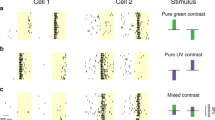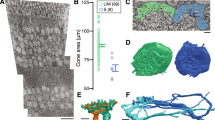Abstract
Visual abilities change over the visual field. For example, our ability to detect movement is better in peripheral vision than in foveal vision, but colour discrimination is markedly worse1,2. The deterioration of colour vision has been attributed to reduced colour specificity in cells of the midget, parvocellular (PC) visual pathway in the peripheral retina3,4,5. We have measured the colour specificity (red–green chromatic modulation sensitivity) of PC cells at eccentricities between 20 and 50 degrees in the macaque retina. Here we show that most peripheral PC cells have red–green modulation sensitivity close to that of foveal PC cells. This result is incompatible with the view that PC pathway cells in peripheral retina make indiscriminate connections (‘random wiring’) with retinal circuits devoted to different spectral types of cone photoreceptors4,6,7. We show that selective cone connections can be maintained by dendritic field anisotropy, consistent with the morphology of PC cell dendritic fields in peripheral retina8,9. Our results also imply that postretinal mechanisms contribute to the psychophysically demonstrated deterioration of colour discrimination in the peripheral visual field.
This is a preview of subscription content, access via your institution
Access options
Subscribe to this journal
Receive 51 print issues and online access
$199.00 per year
only $3.90 per issue
Buy this article
- Purchase on Springer Link
- Instant access to full article PDF
Prices may be subject to local taxes which are calculated during checkout




Similar content being viewed by others
References
Noorlander, C., Koenderink, J. J., Den Ouden, R. J. & Edens, B. W. Sensitivity to spatiotemporal colour contrast in the peripheral visual field. Vision Res. 23, 1–11 (1983).
Mullen, K. T. Colour vision as a post-receptoral specialization of the central visual field. Vision Res. 31, 119–130 (1991).
Shapley, R. & Perry, V. H. Cat and monkey retinal ganglion cells and their visual functional roles. Trends Neurosci. 9, 229–235 (1986).
Lennie, P., Haake, P. W. & Williams, D. R. in Computational Models of Visual Processing (eds Landy, M. S. & Movshon, J. A.) 71–82 (MIT Press, Cambridge, MA, 1991).
Mullen, K. T. & Kingdom, F. A. A. Losses in peripheral colour sensitivity predicted from “hit and miss” post-receptoral cone connections. Vision Res. 36, 1995–2000 (1996).
Calkins, D. J. & Sterling, P. Evidence that circuits for spatial and color vision segregate at the first retinal synapse. Neuron 24, 313–321 (1999).
Rodieck, R. W. in From Pigments to Perception: Advances in Understanding Visual Processes (eds Valberg, A. & Lee, B. B.) 83–93 (Plenum, London, 1991).
Dacey, D. M. The mosaic of midget ganglion cells in the human retina. J. Neurosci. 13, 5334–5355 (1993).
Goodchild, A. K., Ghosh, K. K. & Martin, P. R. Comparison of photoreceptor spatial density and ganglion cell morphology in the retina of human, macaque monkey, cat, and the marmoset Callithrix jacchus. J. Comp. Neurol. 366, 55–75 (1996).
Wiesel, T. N. & Hubel, D. H. Spatial and chromatic interactions in the lateral geniculate body of the rhesus monkey. J. Neurophysiol. 29, 1115–1156 (1966).
De Monasterio, F. M. & Gouras, P. Functional properties of ganglion cells of the rhesus monkey retina. J. Physiol. (Lond.) 251, 167–195 (1975).
Lee, B. B., Pokorny, J., Smith, V. C., Martin, P. R. & Valberg, A. Luminance and chromatic modulation sensitivity of macaque ganglion cells and human observers. J. Opt. Soc. Am. 7, 2223–2236 (1990).
Wässle, H., Grünert, U., Martin, P. R. & Boycott, B. B. Immunocytochemical characterization and spatial distribution of midget bipolar cells in the macaque monkey retina. Vision Res. 34, 561–579 (1994).
Packer, O. S., Williams, D. R. & Bensinger, D. G. Photopigment transmittance imaging of the primate photoreceptor mosaic. J. Neurosci. 16, 2251–2260 (1996).
Roorda, A. & Williams, D. R. The arrangement of the three cone classes in the living human eye. Nature 397, 520–522 (1999).
Smith, V. C., Lee, B. B., Pokorny, J., Martin, P. R. & Valberg, A. Responses of macaque ganglion cells to the relative phase of heterochromatically modulated lights. J. Physiol. (Lond.) 458, 191–221 (1992).
Derrington, A. M. & Lennie, P. Spatial and temporal contrast sensitivities of neurones in lateral geniculate nucleus of macaque. J. Physiol. (Lond.) 357, 219–240 (1984).
Dreher, B., Fukada, Y. & Rodieck, R. W. Identification, classification and anatomical segregation of cells with X-like and Y-like properties in the lateral geniculate nucleus of Old-World primates. J. Physiol. (Lond.) 258, 433–452 (1976).
Gouras, P. & Zrenner, E. Enhancement of luminance flicker by color-opponent mechanisms. Science 205, 587–589 (1979).
Lankheet, M. J. M., Lennie, P. & Krauskopf, J. Temporal–chromatic interactions in LGN P-cells. Visual Neurosci. 15, 47–54 (1998).
Kaplan, E., Lee, B. B. & Shapley, R. M. in New Views of Primate Retinal Function Vol. 9 (eds Osborne, N. & Chader, J.) 273–336 (Pergamon, New York, 1989).
Dacey, D. M. Primate retina: cell types, circuits and color opponency. Prog. Retin. Res. 18, 737–763 (1999).
Smith, E. L., Chino, Y. M., Ridder, W. H., Kitagawa, K. & Langstom, A. Orientation bias of neurons in the lateral geniculate nucleus of macaque monkeys. Visual Neurosci. 5, 525–545 (1990).
Watanabe, M. & Rodieck, R. W. Parasol and midget ganglion cells of the primate retina. J. Comp. Neurol. 289, 434–454 (1989).
Roorda, A., Metha, A., Lennie, P. & Williams, D. R. Packing arrangement of the three cone classes in primate retina. Vision Res. (in the press).
Wong, W. T., Faulkner-Jones, B. E., Sanes, J. R. & Wong, R. O. Rapid dendritic remodeling in the developing retina: dependence on neurotransmission and reciprocal regulation by Rac and Rho. J. Neurosci. 20, 5024–5036 (2000).
Navarro, R., Artal, P. & Williams, D. R. Modulation transfer of the human eye as a function of retinal eccentricity. J. Opt. Soc. Am. 10, 201–212 (1993).
Acknowledgements
We thank B. Roser and B. Grünert for technical assistance; B. Dreher, U. Grünert, P. Lennie and H. Wässle for helpful discussions and suggestions; A. Goodchild and K. Ghosh for Neurobiotin labelling of ganglion cells; and A. Roorda for cone matrix data.
Author information
Authors and Affiliations
Corresponding author
Rights and permissions
About this article
Cite this article
Martin, P., Lee, B., White, A. et al. Chromatic sensitivity of ganglion cells in the peripheral primate retina. Nature 410, 933–936 (2001). https://doi.org/10.1038/35073587
Received:
Accepted:
Issue Date:
DOI: https://doi.org/10.1038/35073587
This article is cited by
-
Macular superficial vascular density on optical coherence tomography angiography in children with unilateral anisometropic and bilateral hyperopic amblyopia
Scientific Reports (2023)
-
Incorporating the properties of peripheral vision into theories of visual search
Nature Reviews Psychology (2022)
-
Oculomotor system can differentially process red and green colors during saccade programming in the presence of a competing distractor
Experimental Brain Research (2022)
-
The influence of temporal frequency and stimulus size on the relative contribution of luminance and L-/M-cone opponent mechanisms in heterochromatic flicker ERGs
Documenta Ophthalmologica (2021)
-
Neural circuits in the mouse retina support color vision in the upper visual field
Nature Communications (2020)
Comments
By submitting a comment you agree to abide by our Terms and Community Guidelines. If you find something abusive or that does not comply with our terms or guidelines please flag it as inappropriate.



